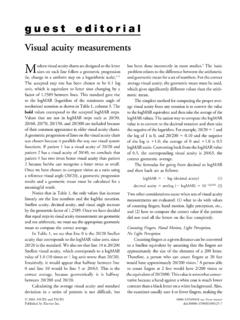Transcription of Negative dysphotopsia: The enigmatic penumbra
1 Negative dysphotopsia : The enigmatic penumbraJack T. Holladay, MD, MSEE, Huawei Zhao, PhD, Carina R. Reisin, PhDPURPOSE:To determine the cause of Negative dysphotopsia and the location, appearance, andrelative intensity of such images in pseudophakic :Baylor College of Medicine, Houston, Texas, :Reporting available data addressing a specific clinical : Negative dysphotopsia was simulated using the Zemax optical design program. Thenominal values for the pseudophakic eye model were as follows: IOL power, diopters (D); cor-neal power, D; Q value, ; axial IOL depth behind pupil, mm; external anterior chamberdepth (corneal vertex to iris plane), mm; optic diameter, mm; pupil diameter, :From the first ray-tracing simulation, analysis of the image for the nominal parametersshowed 2 annuli (ring-shaped) shadows. The inner annulus shadow was located from a retinalvisual field angle of to degrees (width degrees), and the outer annular shadowwas located from to degrees (width degrees).
2 Superimposing the innerannulus on the human visual field showed that the shadow would be apparent only temporally,where it is within the limits of the visual field and functional retina. The patient would perceivethis as a temporal dark crescent-shaped partial shadow ( penumbra ).CONCLUSIONS:Primary optical factors required for Negative dysphotopsia are a small pupil,a distance behind the pupil of mm or more and mm or less for acrylic, a sharp-edgeddesign, and functional nasal retina that extends anterior to the shadow. Secondary factorsinclude a high index of refraction optic material, anglea, and the nasal location of the pupilrelative to the eye s optical Disclosure:Drs. Zhao and Reisin are employees of and Dr. Holladay is a consultant toAbbott Medical Optics, Inc. No author has a financial or proprietary interest in any material ormethod Cataract Refract Surg 2012; 38:1251 1265Q2012 ASCRS and ESCRSU nwanted optical images can arise after the implanta-tion of intraocular lenses (IOLs).
3 These includedysphotopsia, defined as unwanted patterns on theretina that can be positive or Negative . Positive dys-photopsia consists of bright artifacts, such as arcs,1streaks,2rings, or halos3on the retina centrally ormidperipherally, but not on the extreme dysphotopsia is the absence of light reachingcertain portions of the retina that manifests as a dysphotopsia , first described more than10 years ago,4manifests as a temporal dark crescent-shaped shadow after in-the-bag posterior chamberIOL implantation. The mechanism of this disorderhas remained a clinical enigma, with proposed expla-nations that include IOL material with a high index ofrefraction,4 6optics with a sharp or truncated edge,4,6idiosyncratic predisposition,7a cataract incisionlocated temporally in clear cornea,8brown irides,8a prominent globe,9a shallow orbit,9an IOL anteriorsurface that is more than mm from the plane ofthe posterior iris,9a Negative afterimage,10neural ad-aptation,10and reflection of the anterior capsulotomyedge projected onto the nasal peripheral additional articles and letters with case reportsshowing the absence of some of these suggested mech-anisms have also been 15 Some of theseclinical observations may be valid and weresummarized by Masket and Fram11in their 10 1999, Holladay et al.
4 ,1using a nonsequentialray-tracing technique, compared the image andrelative intensity of reflected glare images from 4 com-monly used IOL edge designs to assess the potentialfor noticeable postoperative edge glare. Their resultsindicated that a sharp or truncated optic edge wasQ2012 ASCRS and ESCRSP ublished by Elsevier $ - see front matter1251doi: SCIENCEthe most significant factor in positive dysphotopsiadue to an intense peak of reflected glare light on theretina. A few years later, Erie et ,17found that re-flections from the front and back surfaces of equicon-vex unequal biconvex designs and a higher index ofrefraction optic materials were also factors that in-creased the relative intensity of the reflected lightfrom 300- to 3500-fold above that of the crystallinelens. Several subsequent studies18 32confirmed thesefactors to be important in producing phenomenon of Negative dysphotopsia hasremained an enigma.
5 To date there has been little the-oretical exploration and computer modeling to explainnegative dysphotopsia . The current study wasdesigned to evaluate Negative dysphotopsia usingray tracing and to illustrate the phenomenon usinga common light source (direct ophthalmoscope) andlens in an effort to explain relevant observations andto review methods of eliminating the problem fromclinical AND METHODSEye-Model SpecificationsThe Zemax optical design program (Zemax DevelopmentCorp.) was used to evaluate Negative dysphotopsia . The pro-gram generates ray-tracing models of simple and complexoptical systems based on user-defined 1shows the nominal values used in this study s pseu-dophakic model. Other values for these parameters werealso used to determine their effect on the image location asfollows: IOL power, D and D; corneal power, D and D; axial IOL depth behind pupil, mmand mm; external ACD, mm and mm; and pupildiameter, extended light source (object) was Ganzfeld (similarto a Goldmann or Humphrey visual field perimeter), whichextended from 0 degree (foveal fixation) to 125 degreesperipherally (along the visual axis of the eye model) and360 degrees around the visual axis 1 m from the nodal pointof the eye model, which was located near the posterior vertexof the IOL.
6 The IOL edge design was sharp, truncated, orround (Figure 2).Ray-Tracing CalculationsTwo types of ray-tracing calculations were performed. Inthe first ray-tracing simulation, the extended light source(Ganzfeld) was treated as a Lambertian scattering object.(Each point on the surface was treated as a point source.) Itwould be identical to the Goldmann visual field perimeteras the object, except it is at 1 m (rather than 33 cm). The anal-yses traced 1 billion rays from the extended source throughthe pupil in the pseudophakic eye model, with the largenumber of rays ensuring an adequate intensity and spatiallocation on the retina for each possible condition intensity and the location of all light rays reaching thesimulated pseudophakic eye model retina were recordedas shown for the mm pupil inFigure the second ray-tracing simulation, only the horizontalsection was considered.
7 Because the ray tracing is radiallysymmetric around the optical axis, this provides a conceptualmodel that can be used to envision the optical performance ofthe IOL in a single plane. Rays from 0 to 125 degrees weretraced to determine the minimum and maximum angles inwhich a ray could pass through the pupil and edge of theIOL for the nominal and other values shown inTable coordinates of the intercepts at each surface and the loca-tion of all light rays reaching the simulated pseudophakic eyemodel retina are recorded inTable 1and shown inFigure 4for the nominal parameters and a mm , a direct ophthalmoscope was used as an extendedlight source to project a beam of light onto and near the edgeof a D IOL, as shown in the upper part of the 3 images inFigure the first ray-tracing simulation using a Lamber-tian light source, analysis of the image of the extendedlight source using the nominal parameters for a mmpupil specified inTable 1showed 2 annular (ring-shaped) shadows (Figure 3).
8 The inner annulusshadow was located from a retinal field angle of degrees (width degrees), and the outer an-nular shadow was located from to degrees( degrees wide).Table 1shows the ray-tracingvalues for the nominal values and all other combina-tions of variables. The 4 primary factors determiningthe presence and location of a shadow were the sizeof the pupil, the axial distance of the IOL behind theiris, a sharp or truncated edge, and the high index ofrefraction optic material (acrylic).Table 1shows that the lower index of refractionsilicone compared with acrylic moved the anteriorborder of the shadow forward by approximately 5 de-grees and the posterior border forward by 15 degrees,reducing the width of the shadow from degreesfor acrylic to degrees for silicone. The exact widthand location of the shadows were not appreciablyaffected by the dioptric power of the IOL, externalACD, or power of the cornea.
9 As the pupil size wasSubmitted: February 11, revision submitted: January 27, : January 29, the Department of Ophthalmology (Holladay), Baylor Collegeof Medicine, Houston, Texas, and Abbott Medical Optics (Zhao,Reisin), Santa Ana, California, in part at the annual meeting of the Association forResearch in Vision and Ophthalmology, Fort Lauderdale, Florida,USA, April author: Jack T. Holladay, MD, MSEE, HolladayConsulting, Inc., PO Box 717, Bellaire, Texas 77402-0717, SCIENCE: Negative DYSPHOTOPSIAJ CATARACT REFRACT SURG -VOL 38, JULY 2012increased to mm, the location of the shadow re-mained the same, but the edges became indistinctand rays from other angles fell into the shadow, reduc-ing its contrast so it would not be visible to an observer(Figure 6). Figure 7is the ray tracing for the horizontalsection forFigure 6using the mm the image (annular shadow) for mm pupil and nominal values with the sharp-edged optic on the human visual field showed thatonly the temporal portion of the inner annular shadowwould be apparent, where it is within the limits of thevisual field and functional retina (Figure 8).
10 The patientwould perceive a temporal dark crescent-shapedshadow through a mm pupil (Figures3 and 4) andno shadow through a mm pupil (Figures6 and 7).Using a direct ophthalmoscope as an extended lightsource and a D IOL, a shadow was illustratedwhen the light source was incident on the edge ofthe IOL such that unrefracted light rays passed byand refracted light passed through the edge of theIOL (Figure 5).DISCUSSIONU nwanted shadows in most optical systems are a re-sult of discontinuities in the system where 2 adjacentFigure section of the sche-matic human right pseudophakic eyeused for Zemax modeling. The pseudo-phakiceyemodelhadthefollowingnom- inal values: IOL D; D; Q-valueZ ; axialIOL depth from corneal epithelial vertextoanteriorvertexof ; exter-nal ACD from corneal epithelial vertex toiris mm; IOL optic diameterZ6 mm; index of refraction of IOL opticmaterial(acrylic) ; pupil mm; retinal mm(center @ C ).






